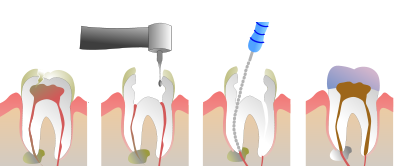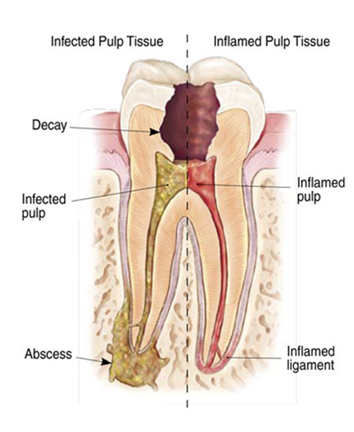|

What is Root Canal Treatment (a root canal)?
Root canal treatment (also called a root canal) is done when decay will likely damage or has already killed a tooth. During a root canal, a dentist or endodontist removes the pulp from the center of a tooth and fills the pulp cavity.
Why root canal treatment is necessary?
Root canal treatment can prevent the development of a painful infection in the pulp that may spread to other teeth. A root canal can also treat an infection that has developed into an abscessed tooth. This procedure can relieve toothache, stop infection, and promote healing. Root Canal Treatment is the last option to save the tooth failing which the tooth has to be extracted.

Signs & Symptoms:
If you have an infection of the pulp, you may not feel any pain at first. But if left untreated, the infection will cause pain and swelling. In some cases, an abscess will form. Eventually, the tooth may need to be extracted.
Some indications that a tooth may need a root canal are:
* A tooth that hurts significantly when you bite down on it, touch it or push on it
* Sensitivity to heat
* Sensitivity to cold that lasts longer than a couple of seconds
* Swelling near the affected tooth
* A discolored tooth, with or without pain
* A broken tooth
How a root canal to be performed?
- The dentist will inject a local anesthetic that will completely numb your teeth, gums, tongue, and skin in the that area.?
- The dentist will use a drill to remove the pulp from the tooth and will fill the inside part of the tooth below the gum line with medicines, temporary filling materials, and a final root canal filling.
- After the root canal, a permanent filling or crown (cap) is often needed. If a crown is needed, the dentist removes the decay and then makes a crown to restore the tooth.
- The tooth may be fitted with a temporary crown until the permanent crown is made and cemented into place.
When is RCT required?
When tooth decay occurs and is detected, a normal filling procedure is carried out .However, if this tooth decay is not detected, it progresses to deeper layers and finally reaching the pulp chamber. When the tooth decay reaches the Pulp chamber, there is no alternative but to perform a Root Canal Treatment. This is because, the infection in the pulp chamber must be removed else it will progress further.
After Root Canal Treatment
Your tooth may be sore for two to three days after the procedure, and your dentist will tell you to avoid chewing on the affected side. The worse the infection and inflammation was prior to root canal treatment, the sorer the tooth will be after treatment. You can take over-the-counter pain relievers to ease the discomfort.
What expect after the surgery?
After a root canal, your lips and gums may remain numb for a few hours until the anesthetic wears off. Later you may have throbbing pain, which you can treat with pain medicines, such as ibuprofen, acetaminophen, or a stronger prescription painkiller. Be safe with medicines. Read and follow all instructions on the label. The pain usually lasts only a day or two.
Crowns that seal the top of the tooth and strengthen it may come loose over time. They may need to be repaired, redone, or cemented on again.
How well a root canal works?
A root canal removes the pulp inside the tooth and replaces it with filling material. It can effectively treat or prevent an infection.
|